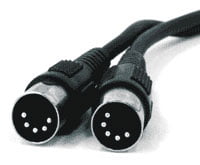The Beginner’s Guide to Common Music Cables
A very common sight in studios, whether a professional or home studio, are cables. Cables connect our instruments and microphones to amplifiers and effect units as well as connecting to recording devices and monitors and speakers. No matter what you do in a studio or in a live situation you will use cables.
It is important to know the differences between and best uses for the common music cables found in the modern studio. This guide will identify and explain those cables.
One thing to always remember about cables is to not skimp on them. They carry the voltage variations that are the sounds you need to record or to project to a crowd. Having good quality cables will help keep noise to a minimum and deliver the voltage variations intact.
Common Types of Cables
There are many different types of cables but this document will address the most common ones you find in a modern studio.
TS Cable
The trusty TS cable, also called an instrument cable or a 1/4 inch cable is a single conductor cable most commonly used to connect instruments to other gear like amplifiers, DI boxes, effects and interfaces. The TS stands for Tip and Sleeve. The tip carries the voltage variations and the sleeve tries to shield it from electronic interference.
TS cables are unbalanced cables and so are quite susceptible to noise interference. Noise that will show up in your recording as hiss or as white noise. Because of this susceptibility the TS cable really should only be used for short runs. Indeed, many studios have a large supply of TS cables of many varying lengths for the sole purpose that one should only use the length one needs and no more in an effort to keep noise to a minimum.
TRS Cable
The TRS cable is also a 1/4 inch cable that can be used for instruments and connecting devices just like the TS cable. TRS stands for Tip, Ring and Sleeve. The main difference between the cables is that the TRS cable is a 2 conductor cable, meaning that there are 2 conductors, the tip and the ring, that carry the voltage variations and a shield, the sleeve, that tries to eliminate noise.
One of the most common uses for a TRS cable is for connecting headphones. The reason is that the 2 conductor cable can carry stereo sound. The TRS cable essentially acts like two TS cables in one. When this cable is used in this way, as a stereo cable, it is still an unbalanced cable for the same reason that a TS is unbalanced. However the TRS cable can also be used as a monophonic balanced cable. Even in this mode the TRS is still susceptible to noise, though not a badly as the TS cable, and should still be used in short runs.
XLR Cable
The XLR cable, also known as a mic cable, is a balanced cable that is used in modern studios. It has 3 conductors and is shielded. One major difference between the TS and TRS and the XLR cable is the XLR cable will usually have a locking mechanism to keep the connection tight. Another big difference is that XLR cables will have a male end and a female end.
Because the XLR cable is shielded and balanced, it can be used in longer runs. In fact, there are many situations that use XLR to go from the front of house to the back of house in a live situation. The are sometimes call snakes. There is a multi-input box on stage that the musicians can plug instruments and microphones into and the snake, which consists of a bundle of XLR cables, run back to the soundboard for mixing before going into the PA system.
Another use of the XLR cable is when using a condenser type microphone that requires phantom power. The 3 conductor configuration allows for that electrical current to be sent from the power source to the microphone. Other Types of Cables
Other Types of Cables
Although the TS, TRS and XLR cables are the most commonly used cables in the studio there are others as well. Here are some and a brief description of their uses.
1/8th Inch Cable
Also called the mini cable or an aux cable. The mini cable is used in headphones as they are balanced and stereo. They are really just a smaller version of the TRS cables.
RCA Cable
RCA cables are used mostly in consumer grade equipment. They function like a single conductor TS cable but are almost always in pair to accommodate stereo sound. You normally see them with a red connector and a white connector.
MIDI Cable
MIDI stands for Musical Instrument Digital Interface and it is a means for electronic musical instruments like synthesizers, drum machine and other electronic sound generators and triggers use to communicate to each other. A single MIDI connection can carry 16 “channels” of information about notes, velocities, video cues, tempos, timing and many other parameters.








